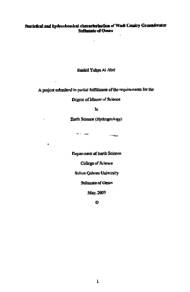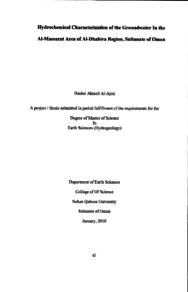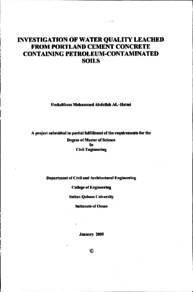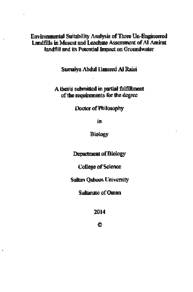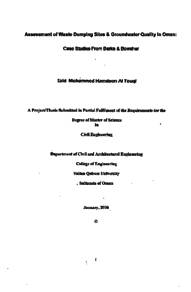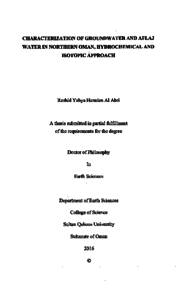Document
Statistical and hydrochemical characterization of Wadi Umairy Goundwater Sultanate of Oman
Publisher
Sultan Qaboos University
Gregorian
2009
Language
English
English abstract
Hydrogeochemical approach is an important tool in groundwater investigations and it has proved to be very useful in fingerprinting the evolution and the quality of water resources in various environmental conditions. Wadi Umairy (project area) is located at the northwestern flank of Oman Mountains and in this area; groundwater is the only source of water. Groundwater distribution is related to the geology as well as the climate. The geology is very complex and the geological structure of these mountains has resulted in equally complex and well developed fracture systems in the rocks forming the mountains. These fractures intercept and store rainfall, which then gradually discharges to springs, or as seepage into adjacent alluvial aquifers. In this setting groundwater is most easily harvested from spring discharge, or by wells and aflaj constructed in alluvial deposits in wadi channels, which also receive recharge when wadi flows occur. The groundwater in various rock units has been studied by analyzing more than forty samples from various aquifers in different locations. The laboratory and field analysis showed the physical and chemical characteristics of the groundwater and the concentrations of major ions and some trace elements. These resulted matrixes of analyzed data were used to identify various groundwater types and their relations with different rock types. The data were also used to characterize the most important factors that control the groundwater quality in the study area using different statistical methods represented by cluster and factor analysis. Three main underlined factors were found to have the major impact in groundwater quality are; natural dissolution and weathering processes, anthropogenic pollution and the degree of the alkalinity. The concentration of observation variables under these three factors lead to the characterization of the groundwater in four main clusters, the first one encompasses the most samples from the northern part regardless the type of aquifer and it is the one which has the main future study domain for the exploitation of various developmental disciplines. The second cluster is found to consist of only one well, which probably penetrate rock unit of different physical and chemical groundwater characteristics. This rock unit is most probably the Hawasina rock units, which contain groundwater of long residential time. Some samples from different rock units are found in cluster three and characterized by high major ions concentrations which is most probably affected by rock units contents while, the fourth cluster represents the highly evolution process at the discharge areas.
Member of
Resource URL
Arabic abstract
أضحت الدراسات الهيدروجيوكيمائية أداة مهمة في معرفة نوعية المياه الجوفية وتطورها في مختلف الظروف البينية. وادي العميري ( منطقة الدراسة) يقع في المنطقة الداخلية من سلطنة عمان حيث حدوده الشمالية تبدأ من الناحية الغربية للجبل الأخضر ويمتد جنوبا لينتهي بالقرب من الحدود العمانية السعودية تعتبر المياه الجوفية في هذه المنطقة المصدر الوحيد لشتى الاستعمالات وكميتها ونوعيتها مرتبطان بعاملين أساسين هما الجيولوجيا والمناخ. إن تواجد الشقوق والكهوف في الصخور المكونة للجبال يساعد بشكل أساسي في إيجاد تجمعات مائية يتم تصريفها من خلال الينابيع الطبيعية أو تتسرب إلى باطن الأرض لتغذية الخزانات الجوفية الغرينية المتاخمة كما يتم تصريف المياه واستغلالها عن طريق الآبار والأفلاج التي شيدت في تلك الرواسب. لقد تم جمع وتحليل أكثر من أربعين عينة خلال هذا المشروع من مختلف الأماكن لمختلف الخزانات الجوفية لتحديد الخصائص الفيزيائية والكيميائية ومعرفة تركيز الأيونات الرئيسية المكونة للماء وكذلك العناصر النادرة وقد أسفرت هذه التحليلات عن تكوين قاعدة بيانات تم استخدامها لتحديد مختلف أنواع المياه الجوفية وعلاقتها بمختلف أنواع الصخور. لقد استخدمت هذه البيانات خلال هذا المشروع لتحديد العوامل الرئيسية المؤثرة في جودة المياه بواسطة بعض الطرق الإحصائية المتمثلة في تحليل وتصنيف العوامل ( cluster and factor analysis) ووجد أن أكثر العوامل تأثيرا هي التجوية والإنحلال الطبيعي للصخور وعمليات التبخر وقدا ثبت باستخدام الطرق التقليدية المعروفة لتصنيف المياه (Piper and Stiff diagrams) والعاملين الأخرين هما التلوث الغير طبيعي ومعامل القلوية. وقد تم تصنيف العينات اللابار والأفلاج) بواسطة الطرق الإحصائية إلى أربع مجموعات، المجموعة الأولى ضمت معظم العينات من أعلى منطقة الدراسة (مناطق التغذية ومن مختلف التراكيب الجيولوجية وهي المجموعة الأكثر استغلالا حاليا وللمستقبل وتتميز بأنها في حدود المواصفات القياسية العمانية لمياه الشرب، المجموعة الثانية ضمت بترا واحدة تمثل المياه ذات العمر الطويل والمحتوي على تراكيز عالية من الأملاح المذابة أما المجموعة الثالثة والتي حوت عينات من مختلف التكوينات في وسط منطقة الدراسة فقد عكست التركيبة الجيولوجية المعقدة وتداخلها وتأثير المعادن المكونة لهذه الصخور في جودة المياه بينما مثلت المجموعة الرابعة المياه الجوفية عالية التطور والتي عادة ما تكون في نهاية مسار المياه الجوفية.
Category
Theses and Dissertations

